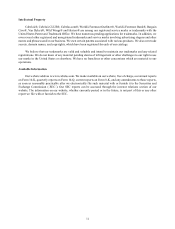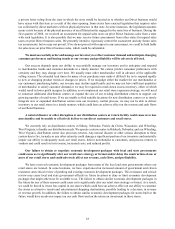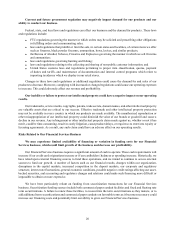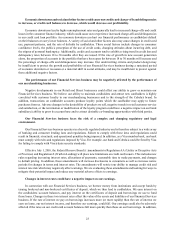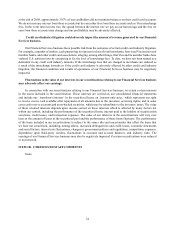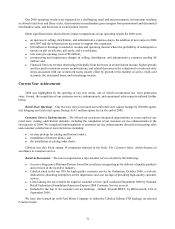Cabela's 2008 Annual Report Download - page 26
Download and view the complete annual report
Please find page 26 of the 2008 Cabela's annual report below. You can navigate through the pages in the report by either clicking on the pages listed below, or by using the keyword search tool below to find specific information within the annual report.21
Furthermore, even if we are able to securitize our credit card loans consistent with past practice, poor
performance of our securitized loans, including increased delinquencies and credit losses, lower payment rates, or
a decrease in excess spreads below certain thresholds, could result in a downgrade or withdrawal of the ratings on
the outstanding securities issued in our securitization transactions, cause earlier than expected repayment of these
securities, or result in higher required credit enhancement levels. This could jeopardize our ability to complete
other securitization transactions on acceptable terms, decrease our liquidity, and force us to rely on other potentially
more expensive funding sources, to the extent available, which would decrease our profitability. If an earlier than
expected repayment of the notes occurs, we may sustain significant losses on our retained interests and our Financial
Services business may need to seek alternative sources of funding. In addition, we may be required to retain all new
receivables on our balance sheet which would require higher allowances for loan losses, increase regulatory capital
requirements, and negatively impact earnings.
We may have to reallocate capital from our Retail and Direct businesses to meet the capital needs of our
Financial Services business, which could alter our retail store expansion program.
Our bank subsidiary must satisfy the capital maintenance requirements of government regulators and its
agreement with Visa U.S.A., Inc. (“Visa”). A variety of factors could cause the capital requirements of our bank
subsidiary to exceed our ability to generate capital internally or from third party sources. For example, government
regulators or Visa could unilaterally increase their minimum capital requirements. Also, we have significant potential
obligations in the form of the unused credit lines of our cardholders. At the end of 2008, these unfunded amounts
totaled approximately $13 billion. Draws on these lines of credit could materially exceed predicted line usage. In
addition, the occurrence of certain events, such as significant defaults in payment of securitized loans or failure
to comply with the terms of securitization covenants, may cause previously completed securitization transactions
to amortize earlier than scheduled or be reclassified as a liability for financial accounting purposes, both of which
would have a significant effect on our ability to meet the capital maintenance requirements of our bank subsidiary,
as affected off-balance sheet loans would immediately be recorded on our consolidated balance sheet and would be
subject to regulatory capital requirements. If any of these factors occur, we may have to contribute capital to our bank
subsidiary, which may require us to raise additional debt or equity capital and/or divert capital from our Retail and
Direct businesses, which in turn could significantly alter our retail store expansion strategy. In addition, our existing
credit agreement limits the amount of capital we can contribute to our bank subsidiary to $25 million in any fiscal
year or $75 million in the aggregate. In December 2008, we made a $25 million capital contribution to our bank
subsidiary through a convertible participating preferred stock investment.
The volatility and disruption of the capital and credit markets as well as downgrades of the ratings on
the outstanding notes issued by our Financial Services business’ securitization trust may negatively impact
our ability to access financing.
While we intend to finance our growth initiatives and operations with existing cash, cash flow from operations,
and borrowings under our existing revolving credit facility, we may require additional financing to support our
growth initiatives and operations. However, due to the existing uncertainty in the capital and credit markets, our
access to capital may not be available on terms acceptable to us or at all. Further, the ability of our Financial Services
business to engage in securitization transactions on favorable terms or at all could be adversely affected by further
disruptions in the capital markets or other events, which could materially affect our business and cause our Financial
Services business to lose an important source of capital.
In addition, on February 19, 2009, Moody’s Investors Service announced that it had downgraded the ratings on
21 classes of asset-backed notes issued by the trust of our Financial Services business. Downgrades could negatively
impact the ability of our Financial Services business to complete other securitization transactions on acceptable
terms or at all and force our Financial Services business to rely on other potentially more expensive funding sources,
to the extent available, which would decrease our profitability. We do not believe that this downgrade will have a
significant impact on the ability of our Financial Services business to complete other securitization transactions on
acceptable terms or to access financing.


